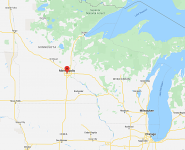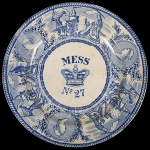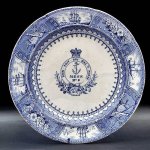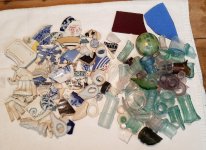Navigation
Install the app
How to install the app on iOS
Follow along with the video below to see how to install our site as a web app on your home screen.
Note: This feature may not be available in some browsers.
More options
You are using an out of date browser. It may not display this or other websites correctly.
You should upgrade or use an alternative browser.
You should upgrade or use an alternative browser.
✅ SOLVED Shards of old plate
- Thread starter Iron Buzz
- Start date
It looks to be made of stoneware as opposed to porcelain, so more likely a 'utilitarian' design to be 'used' instead of a display piece. 
The 'flow-blue decoration' on the edge and the body look to date from 1840 - 60.
My feeling is this piece was likely made in England for retail in the US.
I'd really have to be able examine the fragments to know for sure.
Dave

The 'flow-blue decoration' on the edge and the body look to date from 1840 - 60.
My feeling is this piece was likely made in England for retail in the US.
I'd really have to be able examine the fragments to know for sure.
Dave
Upvote
0
Iron Buzz
Bronze Member
- Oct 12, 2016
- 1,749
- 2,380
- 🏆 Honorable Mentions:
- 1
- Detector(s) used
- XP Deus, Minelab Equinox 800
- Primary Interest:
- Metal Detecting
- Thread starter
- #3
It looks to be made of stoneware as opposed to porcelain, so more likely a 'utilitarian' design to be 'used' instead of a display piece.
The 'flow-blue decoration' on the edge and the body look to date from 1840 - 60.
My feeling is this piece was likely made in England for retail in the US.
I'd really have to be able examine the fragments to know for sure.
Dave
I think you are exactly correct about it being stoneware, Dave.
One person on another site suggested that it could have been from a railroad or ship.
Upvote
0
Plug N Play
Bronze Member
- Aug 23, 2014
- 1,315
- 3,573
- Detector(s) used
- De Havilland Canada DHC-7-102 Dash 7 - Fugro
- Primary Interest:
- All Treasure Hunting
These aren't that hard. First one was easy ... not president, railroad, or ship.
The second one ... please tell us it's curved slightly inwards ... the first one being a plate and the second one being a cup ?
The second one ... please tell us it's curved slightly inwards ... the first one being a plate and the second one being a cup ?
Upvote
0
These aren't that hard. First one was easy ... not president, railroad, or ship.
The second one ... please tell us it's curved slightly inwards ... the first one being a plate and the second one being a cup ?
If the plate frag was found in the South St Paul, MN area it may very well be shipping related.
"Minneapolis is a major city in Minnesota that forms "Twin Cities" with the neighboring state capital of St. Paul.
Bisected by the Mississippi River, it's known for its parks and lakes."
Attachments
Upvote
0
Iron Buzz
Bronze Member
- Oct 12, 2016
- 1,749
- 2,380
- 🏆 Honorable Mentions:
- 1
- Detector(s) used
- XP Deus, Minelab Equinox 800
- Primary Interest:
- Metal Detecting
- Thread starter
- #6
These aren't that hard. First one was easy ... not president, railroad, or ship.
The second one ... please tell us it's curved slightly inwards ... the first one being a plate and the second one being a cup ?
Yes! Good call. I only noticed myself that last night. The two shards are not from one piece, and the smaller one does indeed appear to be from a cup, at the lip. It does still have that same scallop design along the lip edge, but not as clearly designed.
Curious why you say "not president, railroad, or ship" though.
Upvote
0
Iron Buzz
Bronze Member
- Oct 12, 2016
- 1,749
- 2,380
- 🏆 Honorable Mentions:
- 1
- Detector(s) used
- XP Deus, Minelab Equinox 800
- Primary Interest:
- Metal Detecting
- Thread starter
- #7
If the plate frag was found in the South St Paul, MN area it may very well be shipping related.
"Minneapolis is a major city in Minnesota that forms "Twin Cities" with the neighboring state capital of St. Paul.
Bisected by the Mississippi River, it's known for its parks and lakes."
No, not South St Paul. It was closer to New Ulm. The settlers were mostly Welsh in this particular area, though, not German as New Ulm was, if that helps.
Upvote
0
Plug N Play
Bronze Member
- Aug 23, 2014
- 1,315
- 3,573
- Detector(s) used
- De Havilland Canada DHC-7-102 Dash 7 - Fugro
- Primary Interest:
- All Treasure Hunting
Not president, railroad, or ship ... for a fact.
The second one is a cup ... there we go.
Would rather not spoil them.
9 more hrs ? Should be plenty of time.
The second one is a cup ... there we go.
Would rather not spoil them.
9 more hrs ? Should be plenty of time.
Upvote
0
Plug N Play
Bronze Member
- Aug 23, 2014
- 1,315
- 3,573
- Detector(s) used
- De Havilland Canada DHC-7-102 Dash 7 - Fugro
- Primary Interest:
- All Treasure Hunting
Upvote
0
vhs07
Bronze Member
Well, since you challenged me....That wound be from the matching tea cup.( if it's curved )There we go ! vhs07, well done.
And the cup ... that may or may not be a cup ?
View attachment 1850359

Upvote
0
DCMatt
Gold Member
- Oct 12, 2006
- 10,432
- 13,679
- Detector(s) used
- Minelab Equinox 600, EX II, & Musketeer, White's Classic
- Primary Interest:
- Metal Detecting
Another amazing ID!
You all make me proud to be a contributing member on this forum.
The depth and breadth of knowledge along with the research prowess is truly impressive.
You all make me proud to be a contributing member on this forum.
The depth and breadth of knowledge along with the research prowess is truly impressive.
Upvote
0
Plug N Play
Bronze Member
- Aug 23, 2014
- 1,315
- 3,573
- Detector(s) used
- De Havilland Canada DHC-7-102 Dash 7 - Fugro
- Primary Interest:
- All Treasure Hunting
Gotta love the accuracy of ANTIQUARIAN's first post:
Confession: I found this one to be fun. Started with a President and Vice President suggestion. Great thought ... but I'm thinking, "Bigger !"
Bigger than Presidents Yep, this is bigger.
Yep, this is bigger.
Railroads, with their dining cars and marked pottery Nope ... much bigger.
Nope ... much bigger.
Bigger than railroads How about shipping lines, with their cruise lines and fancy dining
How about shipping lines, with their cruise lines and fancy dining  Nope ... bigger.
Nope ... bigger.
Bigger than presidents, railroads, and shipping Yep. These shards, and that particular word, AND, are tied to something far bigger than all of those.
Yep. These shards, and that particular word, AND, are tied to something far bigger than all of those.
Mother Goose.
The earliest recorded version of the poem resembling the modern form was printed around 1765 in London in Mother Goose's Melody.
Had total faith in this site to solve it and have fun at the same time.
A little shard with the word AND ... who woulda thunk it ?
This site !
It looks to be made of stoneware as opposed to porcelain, so more likely a 'utilitarian' design to be 'used' instead of a display piece.
Like, say, a delicate tea set, designed to withstand little girls ?
The 'flow-blue decoration' on the edge and the body look to date from 1840 - 60.
If the house was 1860's, the pottery came after, 1888. Gotta say, that was a great guess, and very close.
(random thought: If you moved your family into a new house, 1860's ... 1888 would be about the time you could expect grandkids of a "tea set" age. he-he)
My feeling is this piece was likely made in England for retail in the US.
Nailed this one, too, Dave. These were made in an English town called Hanley. Staffordshire was a major pottery leader throughout all of Europe. Worldwide distribution was a major factor. Staffordshire was huge, encompassing 5 entire cities. Hanley was a dominant producer in this picture. Polluted and pumping out smoke everywhere, the town was a great place, if you wanted to work. Not so great a place if your interests lay elsewhere. In 1850, a potter in Hanley had a son who preferred the sea. He left school at the edge of 12 and took to an aspiring maritime career. Worked his way up to being a well known and liked captain. He died in 1912 when his ship collided with an iceberg.
You nailed it, Dave. Not only were these made in England, they were Staffordshire ... Hanley-Staffordshire.
I'd really have to be able examine the fragments to know for sure.
Dave, I'd say you did an amazing job with only a picture of a couple of shards !
Dave
Confession: I found this one to be fun. Started with a President and Vice President suggestion. Great thought ... but I'm thinking, "Bigger !"
Bigger than Presidents
 Yep, this is bigger.
Yep, this is bigger.Railroads, with their dining cars and marked pottery
 Nope ... much bigger.
Nope ... much bigger.Bigger than railroads
 How about shipping lines, with their cruise lines and fancy dining
How about shipping lines, with their cruise lines and fancy dining  Nope ... bigger.
Nope ... bigger.Bigger than presidents, railroads, and shipping
 Yep. These shards, and that particular word, AND, are tied to something far bigger than all of those.
Yep. These shards, and that particular word, AND, are tied to something far bigger than all of those.Mother Goose.
The earliest recorded version of the poem resembling the modern form was printed around 1765 in London in Mother Goose's Melody.
Had total faith in this site to solve it and have fun at the same time.
A little shard with the word AND ... who woulda thunk it ?
This site !
Upvote
0
Gotta love the accuracy of ANTIQUARIAN's first post:
Confession: I found this one to be fun. Started with a President and Vice President suggestion. Great thought ... but I'm thinking, "Bigger !"
Bigger than PresidentsYep, this is bigger.
Railroads, with their dining cars and marked potteryNope ... much bigger.
Bigger than railroadsHow about shipping lines, with their cruise lines and fancy dining
Nope ... bigger.
Bigger than presidents, railroads, and shippingYep. These shards, and that particular word, AND, are tied to something far bigger than all of those.
Mother Goose.
The earliest recorded version of the poem resembling the modern form was printed around 1765 in London in Mother Goose's Melody.
Had total faith in this site to solve it and have fun at the same time.
A little shard with the word AND ... who woulda thunk it ?
This site !
It's always a challenge to determine the age of any pottery frags that pop up on a site. You can tell so much more when you can physically examine them. I look at the crazing, the colour of the glaze, the thickness of the pottery, even the texture of the clay or porcelain. But in the end, it's just an uneducated guess by someone who's appeared at too many Antiques Roadshow events.

Here's a sampling of some of the fragments that I've kept from my hunts over the past 10 years.

Attachments
Last edited:
Upvote
0
Top Member Reactions
-
 3592
3592 -
 2079
2079 -
 2056
2056 -
 1195
1195 -
 1088
1088 -
 931
931 -
 895
895 -
 828
828 -
 807
807 -
 796
796 -
 784
784 -
 549
549 -
 537
537 -
 489
489 -
 468
468 -
 443
443 -
E
428
-
 427
427 -
 422
422 -
 403
403
Users who are viewing this thread
Total: 2 (members: 0, guests: 2)


















